Why is My Air Mattress Making a Popping Noise?
Have you ever woken up to the annoying sound of your air mattress popping? It can really mess with your sleep.
Understanding why your air mattress makes these noises is the first step to fixing the problem.
It could be anything from improper inflation, the material stretching, or even changes in the room’s temperature.
Reasons for Air Mattress Popping Noises
In this article, we’ll explore the 6 main reasons for these noises and share tips on how to stop them.
With these solutions, you’ll be able to sleep peacefully and wake up feeling refreshed.
Why is My Air Mattress Making a Popping Noise?
The popping or cracking noises from your air mattress can be both annoying and worrying.
We’re here to help you figure out what’s going on, whether it’s sneaky leaks or the normal wear and tear that happens over time.
Identifying the cause is the first step toward enjoying a quiet and comfortable night’s sleep.
Let’s break down the most common causes:

Air Bubbles
Small holes or leaks can cause air bubbles to form inside the mattress.
When you move around, these bubbles can pop, leading to loud noises.

Friction Against the Floor
If your air mattress rubs against the floor, especially a rough surface, it can create squeaking or popping noises.
Placing a sheet or blanket underneath can help reduce this friction.
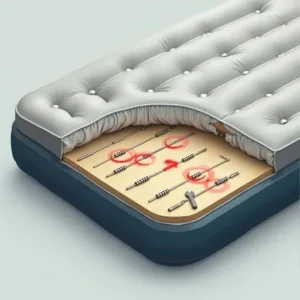
Structural Issues
Worn-out coils, seams, or other internal components can rub together and make popping sounds.
This often indicates that your mattress is getting old and might need repair or replacement.

Trapped Air
Air trapped between the mattress and the floor, or within the mattress itself, can expand or contract with temperature changes, causing popping noises.
Ensuring proper inflation and ventilation can help prevent this.
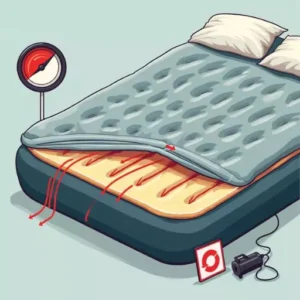
Over-Inflation
Inflating your mattress too much puts extra stress on the seams and materials, which can lead to popping noises or even ruptures.
For best results, inflate to about 90% capacity.

Weight Limit Exceeded
Exceeding the mattress’s weight limit can overstretch the materials which can casue them to wear out faster and make noise.
By understanding these causes, you can take steps to fix the issue and get back to sleeping peacefully without any unexpected noises.
How to Detect the Source of the Noise?
To figure out why your air mattress is making popping noises, follow these steps for a thorough inspection:
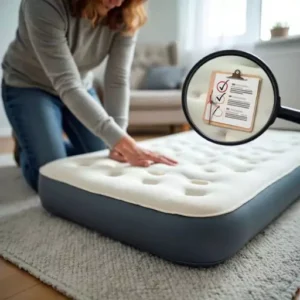
Method #1- Visual Inspection
- What to Do: Carefully examine the entire mattress, paying close attention to the surface, seams, corners, and valves.
- What to Look For: Check for visible damage such as tears, loose threads, or air leaks. Mark any areas that might be problematic.
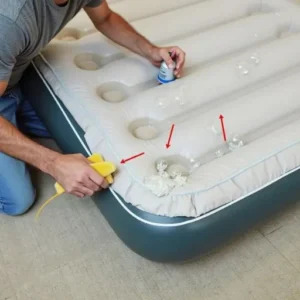
Method #2- Soapy Water Test
- What to Do: Inflate the mattress fully and apply soapy water over the surface.
- What to Look For: Watch for bubbles forming, as this indicates where air is leaking. Focus on the areas you identified during your visual inspection as potential weak points.
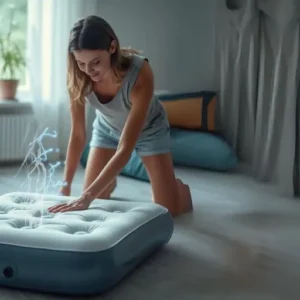
Method #3- Auditory Inspection
- What to Do: Inflate the mattress and listen closely.
- What to Listen For: A hissing sound can reveal where air is escaping from a small puncture. Pay attention to whether the noise is louder in specific areas of the mattress. Conduct this inspection in a quiet environment for the best results.
Tools and Techniques for Inspection
Here are some useful tools and techniques to help you diagnose the noise:
- Soapy Water Mix: Use water mixed with dish soap to detect leaks by observing where bubbles form.
- Flashlight: Helps in finding tiny holes that might not be visible under normal light.
- Noise-Amplifying Device: Useful for detecting subtle hissing sounds that indicate air leakage.
- Notepad and Pen: Keep track of any issues you discover by taking notes.
- Camera: Take photos of any damage you find for reference or repair.
NOTE
Ensure the mattress is fully inflated during the inspection. Perform checks in a well-lit area with minimal background noise for the most accurate results.
Identifying Signs of Wear and Tear
During your inspection, look out for the following signs that might indicate issues with your mattress:
- Visible Holes, Tears, or Loose Threads: These are clear signs of damage.
- Air Bubbles: If bubbles form from seams or small holes, there’s likely a leak.
- Hissing Sounds: This suggests that air is escaping, likely from a small puncture or weak seam.
- Friction Noises: Rubbing or squeaking noises can indicate friction between the mattress and the floor.
- Bulges: Uneven inflation can cause bulging in certain areas.
- Indentations: Indentations that don’t spring back may indicate worn-out areas or improper inflation.
Step-by-Step Practical Solutions to Silence the Pops
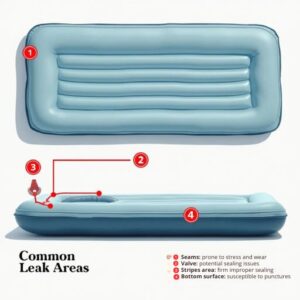
If you’ve figured out what’s causing those annoying popping sounds in your air mattress, it’s time to take action.
Here’s how you can fix the problem and make your nights quieter:
Quick Fixes You Can Do Yourself
You can fix it quickly with a few simple DIY solutions.
Here’s how to get immediate relief and enjoy a quieter sleep:
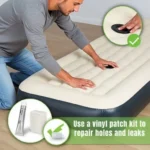
Patch Up Holes and Leaks: If you see any holes, tears, or leaks, grab a vinyl patch kit and cover them up.
This will stop air bubbles from forming and popping inside your mattress.
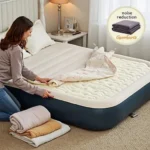
Add a Topper: Place a mattress topper or even some blankets underneath your mattress.
A good topper acts like a shock absorber, reducing noise during the night and adding extra comfort.

Control Room Temperature: Make sure the room isn’t too hot or cold.
Extreme temperatures can cause the air inside the mattress to expand or contract, leading to those pesky pops.
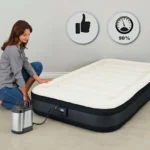
Inflate Properly: Use an electric pump with an automatic shut-off feature to inflate your mattress.
Aim for about 90% capacity, which helps to minimize strain on the seams and keep the weight distributed evenly, reducing the chances of popping sounds.
Best Practices for Even Weight Distribution
To ensure even weight distribution on your air mattress, follow these best practices:
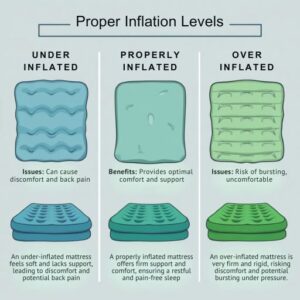
- Proper Inflation: Inflate the mattress to around 90% capacity for adequate firmness and support, avoiding over-inflation which can strain the mattress.
- Even Weight Distribution: Spread body weight evenly across the mattress to prevent excessive pressure on specific areas.
- Choose the Right Size: Use a mattress that’s appropriately sized for the number of sleepers to ensure proper weight distribution.
- Respect Weight Limits: Don’t exceed the mattress’s maximum weight capacity, considering the combined weight of sleepers and bedding.
- Add Extra Padding: If needed, place extra padding like mattress toppers or quilts under the fitted sheet for added cushioning, but be mindful of the extra weight from bedding.
Long-term Maintenance Tips for Your Air Mattress
To keep your air mattress quiet and in good shape for the long run, follow these tips:
Regular Inspections
Check your mattress every so often for any signs of wear and tear, leaks, or other issues.
Catching problems early can save you from bigger headaches later. Inspect for holes, tears, or sharp objects that could cause damage.
Use a Mattress Protector
Cover your mattress with a protector or a cover to guard against punctures, dirt, and moisture. This is super important if you’re using the mattress outdoors.
Proper Storage
When you’re not using your mattress, fully deflate it and store it flat in a cool, dry place, away from sunlight and sharp objects.
Proper storage helps extend the life of your mattress and keeps it quiet over time.
Keep Valves in Good Condition
Regularly check the valves to make sure they are working properly. A well-maintained valve system ensures a secure seal and prevents air leaks, which can contribute to noise.
Regular Maintenance for a Quieter Mattress
To keep your air mattress quiet and functioning well, regular maintenance is key. Here are some tasks to include in your routine:
Inspect for Damage
Regularly check for holes, tears, or other damage, and repair them promptly to prevent noise.
Check Valve Functionality
Ensure that the valves are functioning correctly and are securely sealed to avoid air leakage and noise.
Store Properly
Always store your mattress flat in a cool, dry place to prevent damage and maintain its performance.
Distribute Weight Evenly
Make sure to distribute weight evenly across the mattress every time you use it, as this helps minimize popping sounds and improves comfort.
Consider Upgrading Your Air Mattress
If your air mattress continues to make noise despite your best efforts, it might be time to consider upgrading to a new one. Here’s what to look for:
Look for Quality Materials
Look for air mattresses made with high-quality, durable materials like textile-reinforced plastics, which are less likely to cause noise and wear out over time.
Choose a Quiet Design
Choose a mattress with sound-reducing features, designed to minimize noise and provide a more peaceful sleep environment.
When to Opt for Professional Repair or Replacement?
Identifying the cause of popping noises and applying simple fixes can often solve the issue.
However, some problems require more than a DIY approach. Consider professional repair or replacement if:
- Warranty Coverage: If your mattress is still under warranty, professional repair may be covered by the manufacturer.
- Structural Issues: Noises that suggest structural failure or material deterioration beyond DIY fixes.
- Complex Repairs: Hard-to-reach areas like valves or internal pump issues that are difficult to fix on your own.
- Persistent Leaks: When patching doesn’t solve recurring leaks, it may be time to consult an expert.
- Old Mattresses: If the mattress is old and patches are no longer effective, replacement might be necessary.
Prevention is Better Than Cure
Taking proactive steps to avoid air mattress issues is more effective than fixing them later.
By preventing leaks, reducing wear, and maintaining proper inflation, you can extend your mattress’s life and enjoy many more restful nights.
Proper Storage and Care for Air Mattresses
To keep your air mattress in top shape, follow these storage and care tips:
- Clean and Dry: Always clean your mattress with mild soap and water, then allow it to air dry completely before storing to prevent mold and mildew.
- Deflate Fully: Fully deflate the mattress and fold it loosely to avoid creases and damage. Rolling instead of folding is preferable.
- Store in a Cool, Dry Place: Keep the mattress away from direct sunlight and extreme temperatures to prevent material deterioration.
- Use a Protective Cover: Store the mattress in a protective cover or bag to guard against dust, dirt, moisture, and potential damage.
- Periodic Checks: If storing long-term, check the mattress periodically and air it out to prevent mildew and moisture buildup.
- Inflate Regularly: Inflate and unroll the mattress every 2-3 months to maintain its shape if storing for extended periods.
- Avoid Heavy Objects: Don’t place heavy objects on top of the stored mattress, as this could lead to damage.
- Consider Climate Conditions: Store in a dry, ventilated space with moderate, stable temperatures.
Choosing the Right Air Mattress: Materials and Quality Matters
Picking the right air mattress is not just about comfort—it’s also about making sure you get good quality and materials.
The fabric and construction of the mattress can really impact how long it lasts and how quiet it is when you move around.
Here’s what you should keep in mind to find a mattress that suits your needs and holds up over time.
Firmness Level
The firmness of your mattress is key, and it varies depending on your body weight, how you sleep, and what you like.
For example, side sleepers usually need a softer mattress to relieve pressure on their hips and shoulders, while back and stomach sleepers need something firmer to keep their spine aligned.
If you switch positions a lot during the night, a medium-firm mattress might be the best all-around option.
Mattress Type
There are several types of mattresses, like innerspring, memory foam, latex, hybrid, and airbeds.
Each has its own feel. Memory foam and latex are great for hugging your body’s shape, while innerspring and hybrid mattresses offer a bit more bounce.
Think about what features you need, like pressure relief, motion isolation (so you don’t feel your partner moving), or cooling properties.
Sleeping Position and Body Type
The way you sleep and your body type play a big role in picking the right mattress.
Side sleepers usually do better with softer beds that cushion their shoulders and hips, while people who weigh more might need a firmer mattress for extra support.
If you’re tall, make sure the mattress is long enough for you to stretch out comfortably.
Budget
Mattress prices can vary a lot, from a few hundred to several thousand dollars.
Generally, the more advanced the materials and construction, the more expensive the mattress.
It’s worth spending a bit more for a quality mattress that will last, rather than going for the cheapest option that might wear out quickly.
Additional Needs
Think about any special requirements you might have.
Do you sleep hot? Have back pain? Allergies? Or share your bed with a partner?
These are important factors to consider when choosing a mattress.
Some mattresses are designed with specific features to address these issues, like cooling materials for hot sleepers or extra support for those with back pain.
Advanced Tips and Tricks
Beyond basic care, there are advanced strategies to enhance your air mattress’s life and performance.
In this section, we will discuss lesser-known tips and innovative hacks that can make a big difference.
Here are some advanced tips and tricks for enhancing mattress lifespan:
Innovative Products
Look for mattresses with gel-infused or breathable cooling materials. These can help keep you cool and prevent the mattress from wearing out too quickly.
Modular mattresses that let you replace just the worn-out parts can also extend the life of your bed.
Temperature and Humidity Control in Your Sleeping Environment
- According to the Environmental Protection Agency (EPA), the ideal humidity for sleep is between 30-50%, not going over 60%.
- Dr. Melinda Ratini recommends keeping your bedroom temperature between 60°F and 65°F for the best sleep.
- Tools like dehumidifiers, air conditioning, good ventilation, and moisture-wicking bedding can help keep your sleep environment comfortable.
Final Thoughts
Dealing with popping noises from your air mattress can be frustrating, but the good news is that most of these issues can be fixed with a bit of care and attention.
By figuring out what’s causing the noise—whether it’s air bubbles, friction, or a bit of over-inflation—you can take steps to make your mattress quieter and more comfortable.
Remember to inspect your mattress regularly, keep it properly inflated, and store it the right way when not in use.
If you’ve tried everything and the noise still won’t go away, it might be time to think about getting a new mattress.
With the tips we’ve covered, you should be able to enjoy a peaceful, pop-free night’s sleep.
Frequently Asked Questions (FAQs)
Q1. How do I stop my air mattress from popping?
To prevent your air mattress from popping, make sure it’s inflated to the correct level—not too much or too little. Adding some padding underneath can reduce friction with the floor, which helps prevent damage. If you notice any leaks, patch them up as soon as possible. Also, be mindful of the weight limit to avoid putting too much strain on the seams.
Q2. How do I stop my air mattress from making noise?
To cut down on noise, place a mattress topper underneath the air mattress. This not only makes it quieter but also more comfortable. Keeping the mattress inflated to about 90% can ease the tension on the seams, which helps reduce squeaking. If you hear noises, check for leaks and patch them up. Using a mattress protector can also extend the life of the material and keep things quiet.
Q3. Is it safe to sleep on an air mattress with a bubble?
Sleeping on an air mattress with a bubble isn’t the best idea. A bubble usually means the mattress is overinflated or has a structural problem. This can make the surface uneven, leading to discomfort or even back pain. Plus, there’s a risk that the mattress could deflate during the night. To stay safe and comfortable, it’s better to repair or replace the mattress before using it again.
Q4. How do I get rid of bubbles in my air mattress?
To get rid of bubbles in your air mattress, first, locate the bubble and press down on it while opening the valve to let out some air. Then, slowly reinflate the mattress using an air pump. Check for any leaks using a soapy water test. To prevent bubbles in the future, avoid overinflating the mattress, stick to the weight limit, and keep the mattress clean and well-maintained.
Q5. Why is there a bubble in my air mattress?
Bubbles can form in an air mattress for a few reasons, like overinflation, a factory defect, old age, or exceeding the weight limit. Even a well-maintained mattress can develop bubbles after 5-10 years of use. To prevent this, avoid pumping in too much air, stick to the weight capacity, and take good care of your mattress by cleaning and storing it properly when not in use.

About Michael Smith
Michael Smith is the Content Writer. He loves writing articles that help people understand how to get better sleep. With a background in journalism, Michael turns complicated sleep information into easy-to-read content. He aims to provide practical advice to help readers improve their sleep.

About Michael Smith
Michael Smith is the Content Writer. He loves writing articles that help people understand how to get better sleep. With a background in journalism, Michael turns complicated sleep information into easy-to-read content. He aims to provide practical advice to help readers improve their sleep.

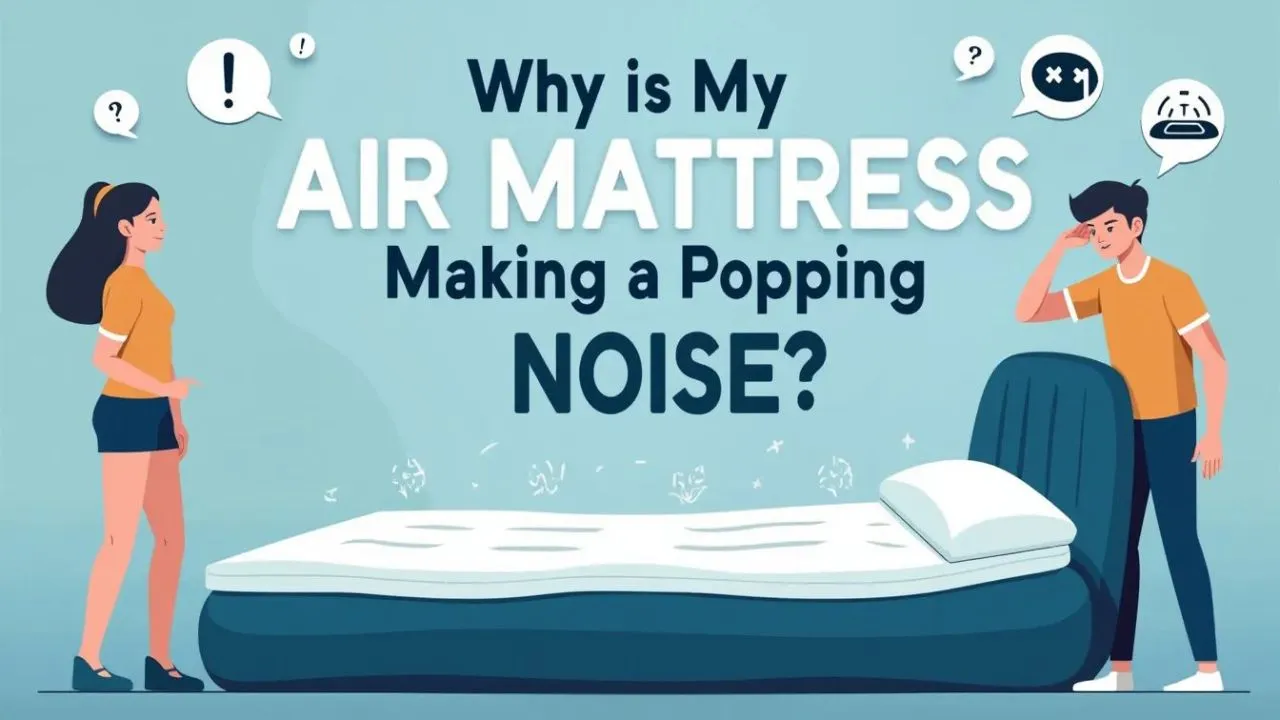
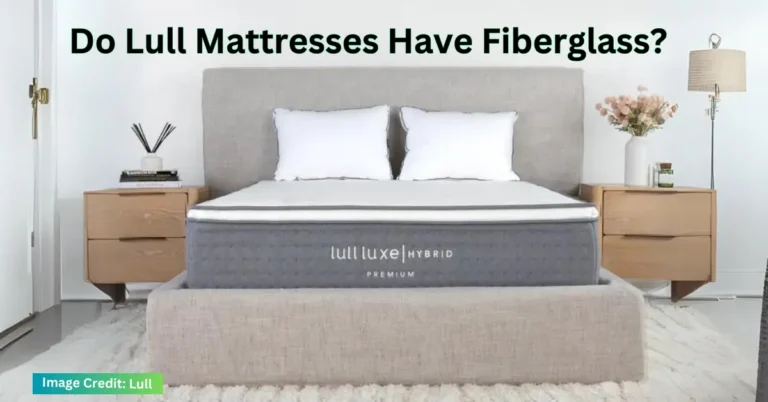
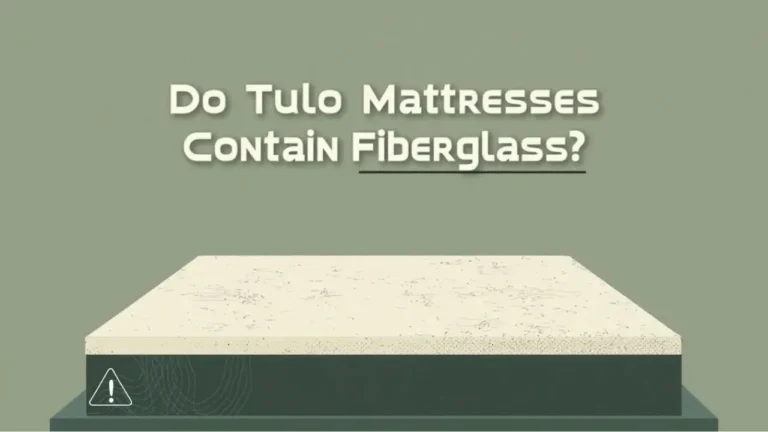
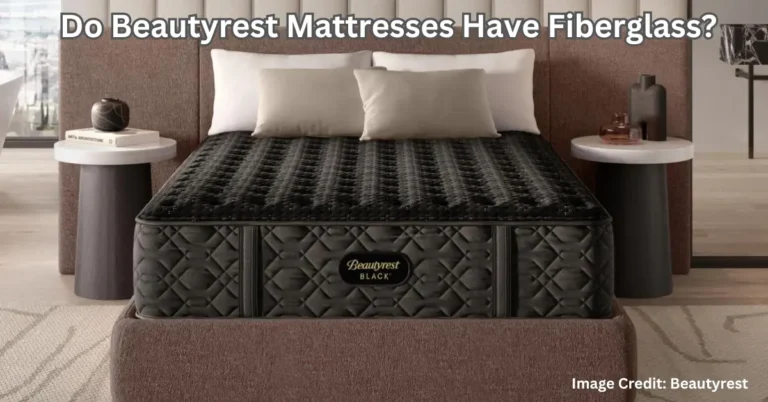
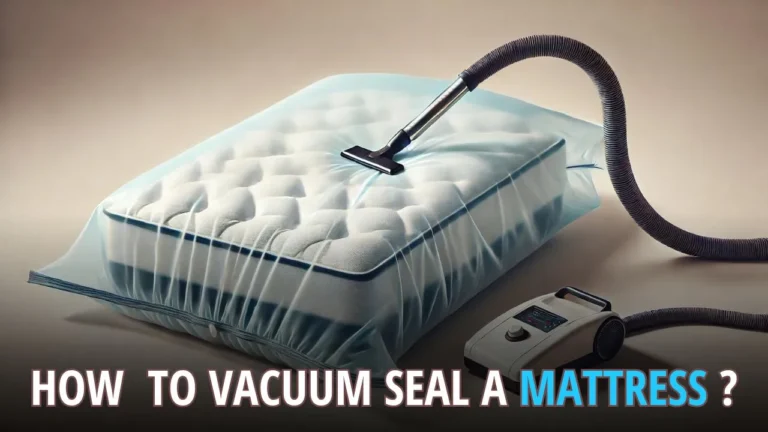
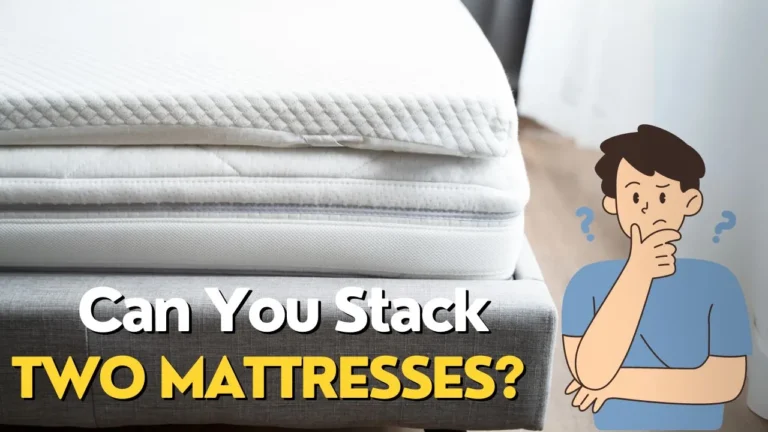
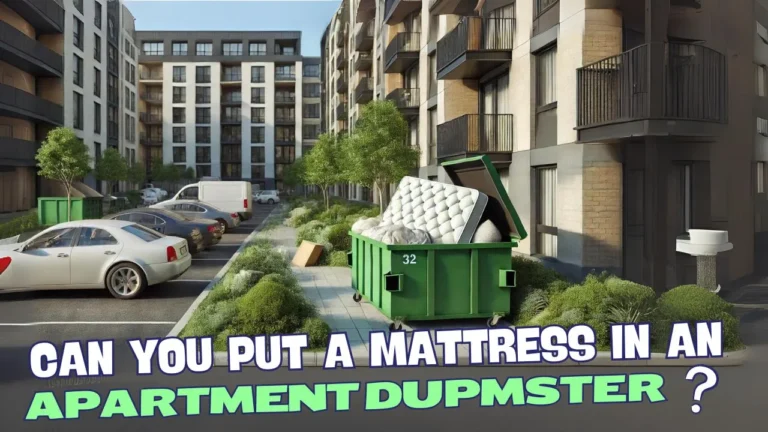
This article is fantastic! Thanks for the helpful info.
Glad to hear, keep visiting our blog for more information about the mattress and sleep related advice.